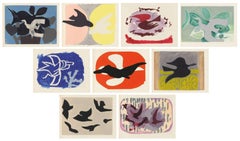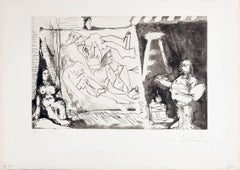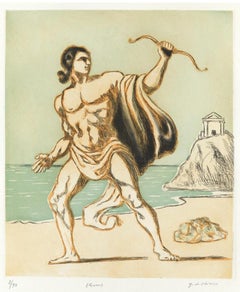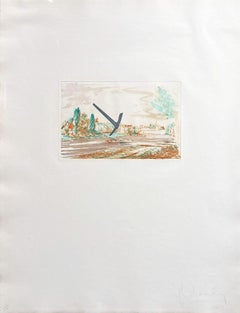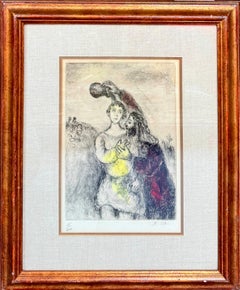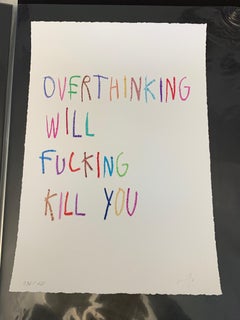Aquatint More Art
to
1
3
2
1
2
Overall Width
to
Overall Height
to
1
5
2
2
2
8
8
4
1
1
1
1
1
4
4
3,254
920
272
259
191
1
1
1
1
1
4
4
Style: Modern
Medium: Aquatint
L'ordre des oiseaux
Located in OPOLE, PL
Georges Braque (1882-1963) - L'ordre des oiseaux
Portfolio with 12 etchings with aquatint from 1962.
The edition XXIX/XXX.
Dimensions of work: 45 x 56 cm.
Apart of an edition of ...
Category
1960s Modern Aquatint More Art
Materials
Etching, Aquatint
Peintre et sa toile avec modèle assis
Located in OPOLE, PL
Pablo Picasso (1881-1973) - Peintre et sa toile avec modèle assis
Etching and aquatint from 1965.
The edition of 33/50.
Dimensions of work: 39 x 51.5 cm.
Hand signed.
Publisher:...
Category
1960s Modern Aquatint More Art
Materials
Etching, Aquatint
$17,713 Sale Price
20% Off
Teseo
Located in New York, NY
Color etching and aquatint, 1970. Signed by the artist in pencil, lower right. Numbered 2/50 in pencil, lower left. Titled in pencil, lower central. With the artist's blind stamp, l...
Category
1970s Modern Aquatint More Art
Materials
Etching, Aquatint
The English Dance of Death - The Dance of Life by Thomas Rowlandson - 1810s
Located in Roma, IT
The English dance of death - The dance of life is an original pair of rare and fine books written by William Combe (25 March 1742 – 19 June 1823) and illustrated by Thomas Rowlandson (13 July 1757 – 21 April 1827) in 1816/1817.
Original First Edition.
Published by Ackermann, London.
Format: in 8°. The dimensions of the book are indicative. The book includes 3 volumes with 295 + 299 + 285 pages.
2 frontispieces and 96 handcolored etchings.
252 pages and 26 handcolored aquatints.
Good conditions.
Thomas Rowlandson (13 July 1757 – 21 April 1827), he was an English artist and caricaturist of the Georgian Era, noted for his political satire and social observation. A prolific artist and printmaker, Rowlandson produced both individual social and political satires, as well as large number of illustrations for novels, humorous books, and topographical works. Like other caricaturists of his age such as James Gillray, his caricatures are often robust or bawdy. Rowlandson also produced highly explicit erotica for a private clientele; this was never published publicly at the time and is now only found in a small number of collections. His caricatures included those of people in power such as the Duchess of Devonshire, William Pitt the Younger and Napoleon Bonaparte.
William Combe (25 March 1742 – 19 June 1823) was a British miscellaneous writer. His early life was that of an adventurer, his later was passed chiefly within the "rules" of the King's Bench Prison. He is chiefly remembered as the author of The Three Tours of Doctor Syntax...
Category
1810s Modern Aquatint More Art
Materials
Paper, Etching, Aquatint
Lovers III - Etchings and Aquatints by Giacomo Manzù - 1970s
Located in Roma, IT
Hand Signed. Edition of 125 prints.
Published in the artwork series: "Giacomo Manzù: Fifteen original etchings and aquatints", by Touchstone Suite, New York, 1970.
Giacomo Manzù (B...
Category
1970s Modern Aquatint More Art
Materials
Etching, Aquatint
Pickaxe (Spitzhacke) Superimposed on a Drawing of the Site by E.L. Grimm
Located in Missouri, MO
Pickaxe (Spitzhacke) Superimposed on a Drawing of the Site by E.L. Grimm, 1982
By Claes Oldenburg (Swedish, American, 1929-2022)
Unframed: 26" x 20"
Framed: 28.75" x 22.75"
Signed and Dated Lower Right
Whimsical sculpture of pop culture objects, many of them large and out-of-doors, is the signature work of Swedish-born Claes Oldenburg who became one of America's leading Pop Artists. He was born in Stockholm, Sweden. His father was a diplomat, and during Claes' childhood moved his family from Stockholm to a variety of locations including Chicago where the father was general consul of Sweden and where Oldenburg spent most of his childhood. He attended the Latin School of Chicago, and then Yale University where he studied literature and art history, graduating in 1950, the same year Claes became an American citizen.
Returning to Chicago, he enrolled at the Art Institute of Chicago from 1952 to 1954 and also worked as a reporter at the City News Bureau. He opened his own studio, and in 1953, some of his satirical drawings were included in his first group show at the Club St. Elmo, Chicago. He also painted at the Oxbow School of Painting in Michigan.
In 1956, he moved to New York where he drew and painted while working as a clerk in the art libraries of Cooper-Union Museum for the Arts of Decoration. Selling his first artworks during this time, he earned 25 dollars for five pieces.
Oldenburg became friends with numerous artists including Jim Dine, Red Grooms and Allan Kaprow, who with his "Happenings" was especially influential on Oldenburg's interest in environmental art. Another growing interest was soft sculpture, and in 1957, he created a piece later titled Sausage, a free-hanging woman's stocking stuffed with newspaper.
In 1959, he had his first one-man show, held at the Judson Gallery at Washington Square. He exhibited wood and newspaper sculpture and painted papier-mache objects. Some viewers of the exhibit commented how refreshing Oldenburg's pieces were in contrast to the Abstract Expressionism, a style which much dominated the art world. During this time, he was influenced by the whimsical work of French artist, Bernard Buffet, and he experimented with materials and images of the junk-filled streets of New York.
In 1960, Oldenburg created his first Pop-Art Environments and Happenings in a mock store full of plaster objects. He also did Performances with a cast of colleagues including artists Lucas Samaras, Tom Wesselman, Carolee Schneemann, Oyvind Fahlstrom and Richard Artschwager, dealer Annina Nosei, critic Barbara Rose, and screenwriter Rudy Wurlitzer.
His first wife (1960-1970) Pat Muschinski, who sewed many of his early soft sculptures, was a constant performer in his Happenings. This brash, often humorous, approach to art was at great odds with the prevailing sensibility that, by its nature, art dealt with "profound" expressions or ideas.
In December 1961, he rented a store on Manhattan's Lower East Side to house "The Store," a month-long installation he had first presented at the Martha Jackson Gallery in New York. This installation was stocked with sculptures roughly in the form of consumer goods.
Oldenburg moved to Los Angeles in 1963 "because it was the most opposite thing to New York I could think of". That same year, he conceived AUT OBO DYS, performed in the parking lot of the American Institute of Aeronautics and Astronautics in December 1963.
In 1965 he turned his attention to drawings and projects for imaginary outdoor monuments. Initially these monuments took the form of small collages such as a crayon image of a fat, fuzzy teddy bear looming over the grassy fields of New York's Central Park (1965) and Lipsticks in Piccadilly Circus, London (1966). Oldenburg realized his first outdoor public monument in 1967; Placid Civic Monument took the form of a Conceptual performance/action behind the Metropolitan Museum of Art, New York, with a crew of gravediggers digging a 6-by-3-foot rectangular hole in the ground.
Many of Oldenburg's large-scale sculptures of mundane objects elicited public ridicule before being embraced as whimsical, insightful, and fun additions to public outdoor art. From the early 1970s Oldenburg concentrated almost exclusively on public commissions.
Between 1969 and 1977 Oldenburg had been in a relationship with Hannah Wilke, feminist artist, but in 1977 he married Coosje van Bruggen, a Dutch-American writer and art historian who became collaborator with him on his artwork. He had met her in 1970, when she curated an exhibition for him at the Stedelijk Museum in Amsterdam. Their first collaboration came when Oldenburg was commissioned to rework Trowel I, a 1971 sculpture of an oversize garden tool, for the grounds of the Kröller-Müller Museum in Otterlo, the Netherlands.
Oldenburg has officially signed all the work he has done since 1981 with both his own name and van Bruggen's. In 1988, the two created the iconic Spoonbridge and Cherry sculpture for the Walker Art Center in Minneapolis, Minnesota that remains a staple of the Minneapolis Sculpture Garden as well as a classic image of the city. Typewriter Eraser...
Category
20th Century American Modern Aquatint More Art
Materials
Etching, Aquatint, Photogravure
Plate VI from Espriu
Located in Fort Lauderdale, FL
Plate VI from the portfolio of nine works to illustrate Poems by Salvador Espriu. Published by Sala Gaspar, Barcelona in 1975 and printed by J.J. Torralba, Rubi (Barcelona). Signed...
Category
21st Century and Contemporary Modern Aquatint More Art
Materials
Engraving, Etching, Aquatint
Price Upon Request
La Fronde
Located in Fort Lauderdale, FL
Signed and numbered to lower edge ‘48/75 Miró’. This work is number 48 from the edition of 75 published by Maeght Éditeur, Paris.
Literature: Dupin 501
Category
21st Century and Contemporary Modern Aquatint More Art
Materials
Etching, Aquatint
Price Upon Request
Related Items
The Anointing of Saul
By Marc Chagall
Located in OPOLE, PL
Marc Chagall (1887-1985) - The Anointing of Saul
Etching from 1958.
Edition of 100
Enhanced with watercolour by the artist.
Dimensions of work: 52 x 37 cm.
Hand signed.
Publish...
Category
1950s Modern Aquatint More Art
Materials
Etching
Over Thinking Will Fucking Kill You Screen Print CB HOYO Urban Art Street
By CB Hoyo
Located in Draper, UT
CB Hoyo’s irreverent multidisciplinary practice—which spans painting, sculpture, and installation—approaches art-world fraud, forgery, and hype with a sense of humor. The self-taught...
Category
2010s Pop Art Aquatint More Art
Materials
Screen
$2,000 Sale Price
20% Off
H 16.5 in W 11.35 in
Taku Obata Signed And Numbered Art Book Zine Edition of 200 Street Art Japan
Located in Draper, UT
Taku Obata Signed And Numbered Art Book Zine Edition of 200 Street Art Japan.
Thick heavy stock paper with vibrant inks.
8 1/4 × 6 in
21 × 15.2 cm
Edition 1...
Category
2010s Street Art Aquatint More Art
Materials
Screen
Edgar Plans Sketch Book Signed & Numbered with Hand Finished Doodle
By Edgar Plans
Located in Draper, UT
Book with sketch
11 × 8 in
27.9 × 20.3 cm
Edition 547/1000
Category
2010s Pop Art Aquatint More Art
Materials
Archival Paper, Carbon Pencil, Color Pencil
$1,500
H 11 in W 8 in D 2 in
De Mauvais Sujets - Planche V
By Marc Chagall
Located in OPOLE, PL
Marc Chagall (1887-1985) - De Mauvais Sujets - Planche V
Etching and aquatint from 1958.
An unnumbered and unsigned copy from a limited edition of 153.
Dimensions of sheet: 43.5 x 32.5 cm
Dimensions in frame: 63.2 x 53.2 cm
Publisher: Les Bibliophiles de l’Union Française, Paris.
Printer: Atelier Lacourière et Frélaut, Paris.
Reference: Cramer 35
--
This original color etching comes from De Mauvais Sujets ("The Bad Subjects"), a 1958 illustrated portfolio that paired Marc Chagall’s artwork...
Category
1950s Surrealist Aquatint More Art
Materials
Etching, Aquatint
Les Contes Drolatiques - Rare Book Illustrated by G. Doré - 1861
By Gustave Doré
Located in Roma, IT
Les Contes Drolatiques is an original modern rare book written by Honoré de Balzac (1799 – 1850) and illustrated by Gustave Doré (Strasbourg, 1832 – 23 January 1883) in 1861.
Publis...
Category
1860s Modern Aquatint More Art
Materials
Paper, Etching
$538
H 8.27 in W 5.52 in D 0.04 in
Untitled, Serigraph on Paper, Indian Modern Artist M.F Husain "In Stock"
By M.F. Husain
Located in Kolkata, West Bengal
M.F. Husain - Untitled
Edition - 11/125
40 x 22 inches (unframed size)
Serigraph on Paper, 1998
(Unframed & Delivered)
MF Husain , world acclaimed artist has been famous for various...
Category
1990s Modern Aquatint More Art
Materials
Paper, Digital
$1,730
H 40 in W 22 in D 1 in
Face of the Poet
By Alex Katz
Located in Toronto, Ontario
Adored by collectors and art lovers the world over, Alex Katz is renowned for his elegant and distinctive version of figuration.
Born in 1927, Katz has been dedicated to art-making ...
Category
1970s Pop Art Aquatint More Art
Materials
Aquatint
Le Poeme (The Poem)
By Louis Icart
Located in Fort Washington, PA
Date: 1928
Medium: Etching and aquatint on wove paper
Framed Dimensions: 28.00" x 31.50"
Signature: Signed in pencil at lower right, with the artist’s blindstamp at lower left. “C...
Category
1920s Aquatint More Art
Materials
Etching, Aquatint
Grossbauern
By Emil Nolde
Located in New York, NY
Etching and aquatint, 1918. Wide margins. Second state (of 2) with the darker toned background. Edition of approximately only 13 (in both the first and second states combined). Si...
Category
1910s Expressionist Aquatint More Art
Materials
Etching, Aquatint
La Thora Rouge
By Marc Chagall
Located in OPOLE, PL
Marc Chagall (1887-1985) - La Thora Rouge
Etching and aquatint from 1981.
An unnumbered and unsigned copy outside from signed edition of 60.
Dimensions of sheet: 49.5 x 32.5 cm
D...
Category
1980s Surrealist Aquatint More Art
Materials
Etching, Aquatint
Le Cocu Magnifique - Complete Suite of Etchings by Pablo Picasso - 1968
Located in Roma, IT
In-folio Oblong
Dimensions : 29x39 cm.
Paris
Atelier Crommelynck
1968
Edition of 200 copies including 12 original out-of-text etchings (7 etchings, 4 etchings and acquatint and 1 e...
Category
1960s Cubist Aquatint More Art
Materials
Drypoint, Etching, Aquatint
$52,660
H 11.42 in W 15.36 in D 2.17 in
Previously Available Items
End of Absalom
By Marc Chagall
Located in OPOLE, PL
Marc Chagall (1887-1985) - End of Absalom
Etching and watercolour from 1958.
The edition of 100 on Arches paper.
Dimensions of work: 52 x 37.5 cm.
Hand signed.
Publisher: Tériad...
Category
1960s Modern Aquatint More Art
Materials
Etching, Aquatint
Promise to Jerusalem
By Marc Chagall
Located in OPOLE, PL
Marc Chagall (1887-1985) - Promise to Jerusalem
Etching and watercolour from 1956.
The edition of 100 on Arches paper.
Dimensions of work: 52 x 37.5 cm.
Hand signed.
Publisher: ...
Category
1960s Modern Aquatint More Art
Materials
Etching, Aquatint
Gerson Leiber "Man Smoking" Etching w/ Aquatint c.1985
By Gerson Leiber
Located in San Francisco, CA
Gerson Leiber "Man Smoking" Etching w/ Aquatint c.1985
Rare etching with aquatint by listed American artist Gerson Leiber (1921-2018)
Pencil signed and numbered from an edition of ...
Category
Late 20th Century Modern Aquatint More Art
Materials
Etching, Aquatint
Aquatint more art for sale on 1stDibs.
Find a wide variety of authentic Aquatint more art available on 1stDibs. While artists have worked in this medium across a range of time periods, art made with this material during the 21st Century is especially popular. There are many well-known artists whose body of work includes ceramic sculptures. Popular artists on 1stDibs associated with pieces like this include Piero Dorazio, Katie VanVliet, Pablo Picasso, and Carla Accardi. Frequently made by artists working in the Modern, Contemporary, all of these pieces for sale are unique and many will draw the attention of guests in your home. Not every interior allows for large Aquatint more art, so small editions measuring 0.1 inches across are also available Prices for more art made by famous or emerging artists can differ depending on medium, time period and other attributes. On 1stDibs, the price for these items starts at $1 and tops out at $929,058, while the average work can sell for $1,100.
Still Thinking About These?
All Recently ViewedMore Ways To Browse
Emile Van Marcke
English Bulldog Painting
English Setter Dog Art
Equestrian Scene Paintings
Erotic Woodblock
Estevan Oriol
Everglades Oil Painting
Faberge Egg Clock
Fernando Castro Pacheco
Folk Art Painting Farm
Forest Horse Oil Painting
Fran Lebowitz
Francine Braniard
Frank Baier
George Colin
George Hamilton Paintings
Gerald Marks
Gilbert Magu Lujan
